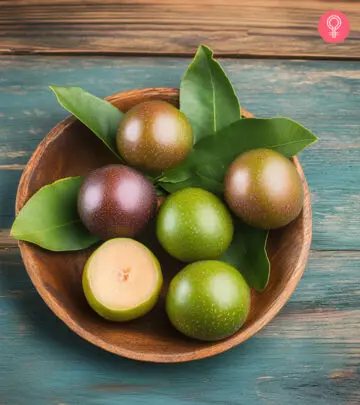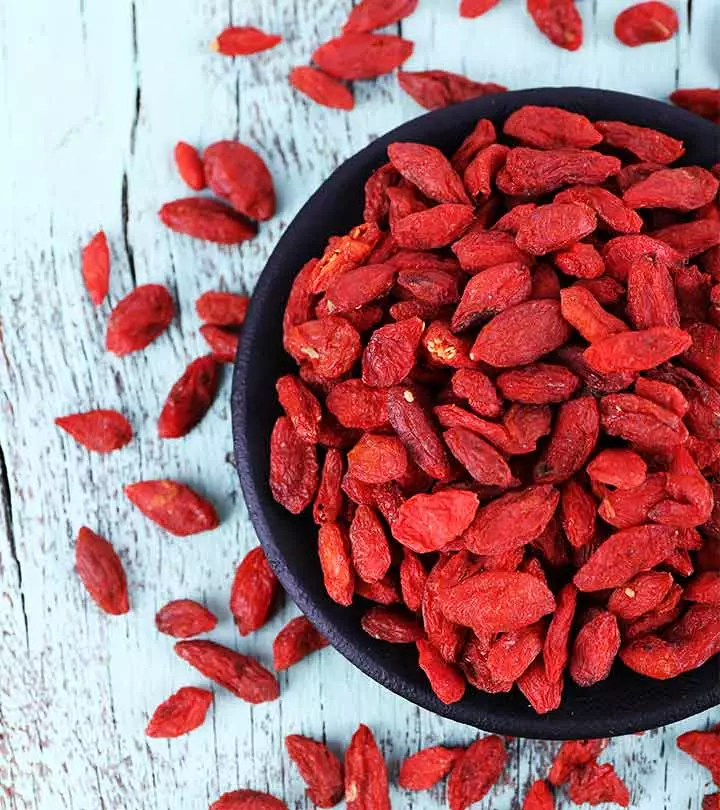5 Health Benefits Of Lentils, Nutrition, And Side Effects
Discover the surprising impact of consuming this wholesome household staple on your health.

Image: Shutterstock
Lentils (Lens culinaris) are gluten-free and easy-to-prepare legumes. There are many health benefits of lentils as they have a high vegetarian protein content and are rich in dietary fiber. Lentils are an essential ingredient in vegan cuisine and a staple in various cuisines across the world, as it can blend with different flavors, making them perfect for soups, salads, or main courses. Bioactive compounds, antioxidants, and polyphenolsi in lentils make them effective against several health problems. Moreover, they strengthen heart health, improve digestion, and can be of benefit to pregnant women. We examine the health benefits of lentils, their nutritional value and recipe ideas, and any side effects in this article. Take a look.
 Know Your Ingredient: Lentils
Know Your Ingredient: LentilsWhat Is It?
A type of edible legume taken from a food crop plant, rich in carbs, proteins, vitamins, and fiber.
What Are Its Benefits?
Good for heart health, digestive health, and managing blood sugar levels.
Who Can Use It?
Anyone can eat them except those prone to constipation and flatulence.
How Often?
Can be included in a regular diet and consumed in moderation.
Caution
Those with digestive and gastrointestinal disorders should not over consume lentils.
In This Article
Different Types Of Lentils

Lentils are classified into different categories based on their color. You can usually find brown, red, green, black, and yellow lentils.
Here are some of the most common types of lentils:
- Brown Lentils: These are the most common variety of lentils. They have a mild, earthy flavor. They are available in colors ranging from light brown to very dark brown. They take 20 to 30 minutes to cook and can hold their shape well during cooking. They taste best in soups and stews.
- Puy or French Green Lentils: These are small and mottled green with a glossy outer cover. They also can retain their shape after cooking and have a peppery taste. They have originated from the French region of Le Puy. These puy lentils have a crunchy texture and are ideal for salads and other side dishes.
 Did You Know?
Did You Know?Carbonized remains of lentils dating back to 11000 BC have been discovered in Greece’s Franchthi Cave. They are the oldest evidence of lentil usage till date.
- Red Lentils: These lentils are the fastest to cook. They can cook within 10 minutes or less. These are a great addition to your meal and are rich in iron. These are the sweetest lentils and have a nutty flavor. You will find them as masoor dal in Indian and Middle Eastern markets.
- Beluga: These are disk-shaped, tiny, and black. They very closely resemble caviar. They are naturally gluten-free and can make a great base for warm salads.
These are some of the important types of lentils available worldwide. We will look at their health benefits in the next section.
A survey done by the U.S Department of Agriculture (USDA) found that Americans consumed approximately 12 pounds of legumes (beans, peas, lentils, and chickpeas) per person in 2017. In the same year, the consumption of lentils reached its all-time high, which is 4.7 pounds per capita, indicating the popularity of these edible legumes.
Key Takeaways
- Lentils (Lens culinaris) are gluten-free, easy-to-prepare legumes rich in protein and nutritional fiber.
- Lentils can protect you against cardiovascular disease, assist the digestive system, prevent tumor growth and cancer cell proliferation, and manage blood sugar levels.
- However, consuming excess lentils may produce adverse effects such as constipation, flatulence, allergic reactions, and more in some people.
What Are The Benefits Of Lentils?
1. May Improve Heart Health

Lentils are rich in bioactive compounds like polyphenols that help reduce the risk of cardiovascular diseases. A review published in the International Journal of Molecular Sciences suggests that consumption of lentils may help protect against cardiovascular diseases (CVD) (1). Another study conducted by the University of Indonesia (Jakarta) found that lentils can protect against cardiovascular diseases (2). Lentil sprouts also showed a positive effect on serum lipid levels in overweight and obese individuals with type 2 diabetes. Intake of 60 grams of lentil sprouts for eight weeks could positively impact their lipid levels (3).
Lentils are also rich in dietary fiber and may help lower LDL cholesterol levels and improve heart health (4), (5). They also can potentially prevent the development of atherosclerosis (build-up of fat in artery walls) (6).
2. May Support Digestive System

Lentils contain prebiotics that help promote the growth of Lactobacillae in the gastrointestinal tract. This, in turn, may promote gut health (7). Their high dietary fiber content also has a protective action against colon cancers (8). Lentils can also help promote bowel movements, prevent constipation, and keep the digestive tract healthy. Another study conducted by the University of Saskatchewan (Canada) found that consumption of green lentils may increase fecal weight (9).
Lorelai Parks, a blogger, shares that lentils help her boost her mood as they keep her gut happy. She prefers them over fast food and states in her blog, “I am in no way saying that lentils will make YOU happy. This is my personal experience….Going through a drive-thru because I am too tired to cook does not make me happy. It makes me feel gross and heavy. It bloats my gut and my gut tells my brain that I am sad and abused, and my brain gets foggy (i).”
3. May Be Beneficial During Pregnancy
One cup of cooked lentils has 358 µg of folate (10). Intake of foods rich in folate may help prevent neural tube defects in babies (11). According to the Centers for Disease Control and Prevention, women should consume 400 mcg of folate every day (12). Pregnant women are also recommended to consume diets rich in high-quality carbohydrates like lentils (13).
4. May Have Anticancer Properties
Lentils contain a unique protein known as plant lectin that has anticancer potential
(14). They act as anticancer agents and may inhibit tumor growth cancer cell proliferation. In addition, the seleniumi An essential component in many enzymes and proteins that helps in DNA synthesis and protects against cell damage and infections. in lentils may help reduce cancer risk (15). A diet rich in selenium may reduce the risk of cancer of the colon, prostate, skin, and bladder. However, more studies are warranted to understand this benefit of lentils in humans.
5. May Help Manage Blood Sugar Levels
A review published in the Journal of Chiropractic Medicinei An alternative medicine that diagnoses, treats, and prevents the mechanical disorders of muscles and bones. suggests that foods high in dietary fibers help control blood sugar levels (16). Another study conducted on 3349 people found that regular lentils can help prevent type 2 diabetes in older adults with high cardiovascular disease risk (17). However, more studies are needed to prove this claim.
Intake of lentils in optimal amounts may also help in weight management (18). The high iron content in lentils may also help treat iron-deficiency related anemia (1).
These are the health benefits of eating lentils. We discuss the nutritional breakdown of lentils in the following section.
Nutrition Profile Of Lentils
According to the U.S. Department of Agriculture, one cup (198 g) of cooked lentils contains (10):
- Calories: 230 kcal
- Protein: 17.9 g
- Fat: 0.752 g
- Carbohydrate: 39.8 g
- Fiber: 15.6 g
- Calcium: 37.6 mg
- Magnesium: 71.3 mg
- Iron: 6.59 mg
- Phosphorus: 356 mg
- Potassium: 731 mg
- Sodium: 3.96 mg
- Zinc: 2.52 mg
- Vitamin C: 2.97 mg
- Niacin: 2.1 mg
- Pantothenic acid: 1.26 mg
- Thiamin: 0.335 mg
- Riboflavin: 0.145 mg
These vitamins, minerals, plant compounds, and phytochemicalsi Bioactive nutrients found naturally in plants that may provide desirable health benefits and reduce the risk of major chronic diseases. offer several health benefits. They also are high in plant protein and dietary fiber. Adding lentils to your daily diet can help you reap their benefits.
How To Add Lentils To Your Diet

- Serve crispy glazed pork belly with aromatic lentils with baked eggs and toast for a luxurious spin of bacon and eggs.
- Add lentils to any soup for added nutrients.
- Warming French lentils with walnuts and goat cheese can be a protein-packed vegetarian lunch option.
- Broil salmon over lentil salad for your dinner.
- Make lentil soup with lots of vegetables.
- Prepare stews with lentils.
- Try making dips and spreads with lentils.
- Use lentils instead of beans in any recipe.
- Precook lentils and keep them in the refrigerator for a quick protein source.
- Make a lentil dip by mashing cooked lentils with a fork and adding garlic, onion, chili powder, and chopped tomatoes.
Lorelai Parks also mentions that she likes to use lentils in her chicken soup recipe. She adds, “In place of the noodles, I’d use lentils which I thought were healthier than noodles, and half the time I don’t like eating flour products anyway, because I find they make me feel sluggish.” She also mentions that this recipe has even helped her friends feel better and raised their spirits.
 Quick Tip
Quick TipYou may also try the following simple and delicious recipes.
3 Simple Recipes You Can Try
1. Red Lentil Curry

What You Need
- Red lentils – 2 cups
- Vegetable oil – 1 tablespoon
- Curry powder – 1 tablespoon
- Onion – 1
- Curry paste – 2 tablespoons
- Ground cumin – 1 teaspoon
- Ground turmeric – 1 teaspoon
- White sugar – 1 teaspoon
- Salt – 1 teaspoon
- Minced garlic – 1 teaspoon
- Minced ginger – 1 teaspoon
- Tomato puree – 1 can (14.25 ounce)
Process
- Wash the lentils in cold water.
- Add lentils to a pot with enough water to cover. Bring to a boil, place a cover on the pot, reduce heat to medium-low, and simmer. Add water during cooking to keep the lentils covered, until tender, for 15 to 20 minutes. Drain.
- Heat vegetable oil in a large skillet over medium heat.
- Cook and stir onions in the hot oil until caramelized, for about 20 minutes.
- Mix curry paste, curry powder, turmeric, cumin, chili powder, salt, sugar, garlic, and ginger in a large bowl. Stir into the onions.
- Increase heat to high and cook, constantly stirring, until fragrant, for 1 to 2 minutes.
- Stir in the tomato puree, remove from heat, and stir into the lentils.
2. Lentil Tacos
What You NeedFor Tacos
- Chopped tomatoes – 1 cup
- Shredded lettuce – 1 cup
- Chopped fresh cilantro – ¼ cup
- Vegan corn or flour tortillas – 8 (6 inches)
- Lime – 1 (cut into eight wedges)
- Guacamole – 1 cup
For Spice Mix
- Ground ancho chili powder – 2 teaspoons
- Ground coriander – ½ teaspoon
- Salt – ½ teaspoon
- Ground fennel seed – ¼ teaspoon
- Ground cumin – 1 teaspoon
- Dried oregano – ½ teaspoon
For Filling
- Cooked brown or green lentils – 2 ½ cups
- Tomato paste – 3 tablespoons
- Minced onion – 1
- Hot sauce – 1 teaspoon
- Water – 2 tablespoons
- Chipotle chilis – 2
- Minced garlic – 2 cloves
- Olive oil – 2 teaspoons
Process
- Combine ancho chili powder, cumin, coriander, oregano, salt, and fennel in a small bowl.
- Heat oil in a large skillet over medium-high heat.
- Cook onion and garlic, occasionally stirring until lightly browned, for about 3 minutes. Add spice mixture and cook, and stir until toasted, for about 30 seconds.
- Reduce heat to medium and add cooked lentils, tomato paste, a few splashes of water, and chipotle peppers.
- Cook, mashing lightly with a fork and adding water if necessary, until lentils are heated through and hold together for about 5 minutes.
- Season with additional salt if needed and adobo or hot sauce.
- Lightly toast tortillas in a cast-iron skillet over medium heat.
- Spread about 1/3 cup of the filling down the center of each tortilla. Top with lettuce, tomatoes, and cilantro. Serve with guacamole and lime wedges.
3. Cranberry Lentil And Quinoa Salad
What You Need
- Dried lentils – 1 cup
- Bay leaves – 2
- Quinoa – 1
- Water – 2 cups
Dressing
- Olive oil – 3 tablespoons
- Finely chopped green onion – 1
- Honey – 1 teaspoon
- Lemon juice – 3 tablespoons
- White wine vinegar – 1 tablespoon
- Salt – ¼ teaspoon
- Dried cranberries – ½ cup
- Crumbled feta cheese – ½ cup
- Coarsely chopped walnuts – ½ cup
- Ground black pepper – to taste
Process
- Place lentils and one bay leaf in a saucepan with enough water to cover and bring to a boil.
- Reduce heat to medium-low and simmer until lentils are tender, for about 30 minutes. Drain and discard the bay leaf. Rinse with cold water until lentils cool. Transfer to a large bowl.
- Bring 2 cups water, quinoa, and remaining bay leaf to a boil in a saucepan.
- Reduce heat to medium-low, cover, and simmer until quinoa is tender and water has been absorbed, for 15 to 20 minutes.
- Rinse quinoa with cold water until cool, and discard the bay leaf. Stir quinoa into lentils.
- Heat lemon juice in a microwave-safe bowl in a microwave until warm, for about 30 seconds.
- Stir honey into juice until dissolved. Add vinegar and salt. Whisk in the olive oil and season with black pepper.
- Pour lemon juice mixture into lentils and quinoa.
- Mix walnuts, cranberries, feta cheese, and green onion into the lentil and quinoa salad.
- Toss to coat. Refrigerate until chilled, for about an hour.
Soaking them for a few hours before cooking can improve their texture and digestibility, while also cutting down on cooking time. Try adding different spices and herbs as you cook to bring out their flavor. This will give your dish a richer, more vibrant taste. Also, lentils need to be stored properly to preserve their freshness and prevent spoilage. Check out the next section for tips on how to store lentils.
How To Store Lentils
- Inspect lentils before storage and discard any discolored or damaged seeds to prevent mold growth.
- Use an airtight container to protect lentils from moisture and pests, and from developing odor.
- Label your lentil container with the purchase date to help track its freshness.
- Store them in a cool, dry, and dark place to prevent flavor and nutritional loss.
- Whole lentils have a longer shelf life, while split lentils have a shorter shelf life.
- Use lentils within a year for optimal taste and texture.
Lentils are generally considered safe for many people. But they may also cause side effects in some. Scroll down to know in detail.
Side Effects Of Lentils
Intake of lentils is generally safe for many. However, lentils also contain compounds like trypsin inhibitorsi A protein and a type of inhibitor that controls the activation and reaction of the enzyme trypsin and other proteins. and anti-nutrients. These compounds include phytic acids that may bind to minerals like zinc, calcium, and iron and reduce their absorption in the body (19). Tannins and lectins are other natural compounds that may prevent the absorption of certain nutrients if consumed in excess (20), (21). The anti-nutrient content of lentils may decrease if they are soaked in water. Intake of lentils in higher amounts may also cause constipation and flatulence. They may even cause allergic reactions due to the presence of Len c 1 and 2 allergens (22). Though more studies are warranted to further understand these side effects, it is best to consult your healthcare provider before increasing your lentil consumption.
Infographic: 5 Major Reasons To Add Lentils To Your Diet
Lentils, used in various cultures, are a prominent feature of many cuisines for their major benefits. If you wish to know more about this potent food and the many reasons why you need to incorporate it into your daily diet regimen, check out the infographic below now!

Illustration: StyleCraze Design Team
Lentils are edible, gluten-free legumes with high protein content. They are rich in dietary fiber, low in calories, and contain several bioactive compounds. All these components are responsible for the immense health benefits of lentils. The intake of lentils may improve heart health, support the digestive system, be beneficial during pregnancy, help in diabetes management, act against tumor cells, and manage blood sugar levels. However, excess intake of lentils may cause some side effects. They may prevent the absorption of nutrients and cause constipation and flatulence. Hence, limit the consumption of lentils to reap their maximum benefits.
Frequently Asked Questions
Do lentils make you gain weight?
No, lentils cannot make you gain weight. Moreover, if consumed in moderation, they effectively help with weight loss because of their low-calorie content.
Do lentils burn belly fat?
Lentils are rich in soluble fiber. If included as part of a healthy diet and coupled with regular exercise, they may help reduce belly fat.
Which color lentil is healthiest?
Black-colored lentils are the healthiest as they are loaded with protein, fiber, calcium, and potassium that can promote overall health.
Do lentils make you poop?
Yes, lentils make you poop. These are packed with fiber that help relieve constipation and ease bowel movements.
Do lentils boost metabolism?
Yes, lentils help boost metabolism as they are high in protein. They are also rich in fiber that helps in the growth of beneficial gut bacteria.
Illustration: Health Benefits Of Lentils Nutrition And Side Effects

Image: Stable Diffusion/StyleCraze Design Team
Learn about the amazing nutritiona; and health benefits of lentils! Discover why lentils are a great addition to your diet and how they can help you stay healthy by watching this video.
Personal Experience: Source
StyleCraze's articles are interwoven with authentic personal narratives that provide depth and resonance to our content. Below are the sources of the personal accounts referenced in this article.
i. I am not a nutritionist but lentils make me happyhttps://lorelai-parks.medium.com/i-am-not-a-nutritionist-ef4a11178973
References
Articles on StyleCraze are backed by verified information from peer-reviewed and academic research papers, reputed organizations, research institutions, and medical associations to ensure accuracy and relevance. Read our editorial policy to learn more.
- Polyphenol-Rich Lentils and Their Health Promoting Effects
https://www.ncbi.nlm.nih.gov/pmc/articles/PMC5713359/ - Candidate foods in the asia-pacific region for cardiovascular protection: “nuts” “soy” lentils and tempe
https://pubmed.ncbi.nlm.nih.gov/11710352/ - Lentil Sprouts Effect On Serum Lipids of Overweight and Obese Patients with Type 2 Diabetes
https://pubmed.ncbi.nlm.nih.gov/26634200/ - Seed Protein of Lentils: “Current Status” “Progress” and Food Applications
https://www.ncbi.nlm.nih.gov/pmc/articles/PMC6769807/ - Dietary fibre intake and risk of cardiovascular disease: systematic review and meta-analysis
https://www.ncbi.nlm.nih.gov/pmc/articles/PMC3898422/ - Comparative Studies on the Antioxidant Activities of Nine Common Food Legumes Against Copper-Induced Human Low-Density Lipoprotein Oxidation In Vitro
https://onlinelibrary.wiley.com/doi/abs/10.1111/j.1750-3841.2007.00464.x?deniedAccessCustomisedMessage=&userIsAuthenticated=false - Plant prebiotics and human health: Biotechnology to breed prebiotic-rich nutritious food crops
https://www.sciencedirect.com/science/article/pii/S0717345814000748 - Dietary Fibre Protective against Colorectal Cancer Patients in Asia: A Meta-Analysis
https://www.ncbi.nlm.nih.gov/pmc/articles/PMC6560290/ - Effect of green lentils on “colonic function” “nitrogen balance” and serum lipids in healthy human subjects
https://pubmed.ncbi.nlm.nih.gov/7491890/ - “Lentils” “mature seeds” “cooked” “boiled” without salt
https://fdc.nal.usda.gov/fdc-app.html#/food-details/172421/nutrients - Folate
https://ods.od.nih.gov/factsheets/Folate-Consumer/ - Folic Acid
https://www.ncbi.nlm.nih.gov/books/NBK554487/ - Current Concepts of Maternal Nutrition
https://www.ncbi.nlm.nih.gov/pmc/articles/PMC4949006/ - Lectins as bioactive plant proteins: a potential in cancer treatment
https://pubmed.ncbi.nlm.nih.gov/16183566/ - Selenium
https://ods.od.nih.gov/factsheets/Selenium-HealthProfessional/ - Dietary Fiber Intake and Type 2 Diabetes Mellitus: An Umbrella Review of Meta-analyses
https://www.ncbi.nlm.nih.gov/labs/pmc/articles/PMC5883628/ - Legume consumption is inversely associated with type 2 diabetes incidence in adults: A prospective assessment from the PREDIMED study
https://pubmed.ncbi.nlm.nih.gov/28392166/ - “Pulse Consumption” “Satiety” and Weight Management
https://academic.oup.com/advances/article/1/1/17/4591548 - Minerals and phytic acid interactions: is it a real problem for human nutrition?
https://ifst.onlinelibrary.wiley.com/doi/abs/10.1046/j.1365-2621.2002.00618.x - “Effect of dehulling” germination and cooking on “nutrients” “anti-nutrients” fatty acid composition and antioxidant properties in lentil (Lens culinaris)
https://www.ncbi.nlm.nih.gov/pmc/articles/PMC5336446/ - “Lectins” “agglutinins” and their roles in autoimmune reactivities
https://pubmed.ncbi.nlm.nih.gov/25599185/ - Lentil (Lens culinaris) lipid transfer protein Len c 3: a novel legume allergen
https://pubmed.ncbi.nlm.nih.gov/21912173/
Read full bio of Silky Mahajan
Read full bio of Sindhu Koganti
Read full bio of Ravi Teja Tadimalla
Read full bio of Moksha Gandhi



























Community Experiences
Join the conversation and become a part of our empowering community! Share your stories, experiences, and insights to connect with other beauty, lifestyle, and health enthusiasts.